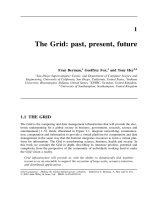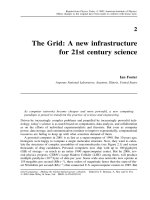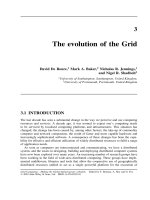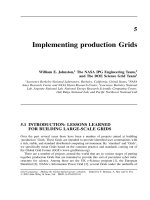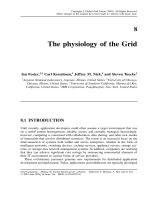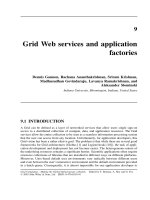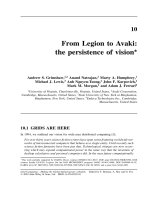Grid Computing P2
Bạn đang xem bản rút gọn của tài liệu. Xem và tải ngay bản đầy đủ của tài liệu tại đây (174.03 KB, 13 trang )
Reprint from Physics Today
2002 American Institute of Physics.
Minor changes to the original have been made to conform with house style.
2
The Grid: A new infrastructure
for 21st century science
Ian Foster
Argonne National Laboratory, Argonne, Illinois, United States
As computer networks become cheaper and more powerful, a new computing
paradigm is poised to transform the practice of science and engineering.
Driven by increasingly complex problems and propelled by increasingly powerful tech-
nology, today’s science is as much based on computation, data analysis, and collaboration
as on the efforts of individual experimentalists and theorists. But even as computer
power, data storage, and communication continue to improve exponentially, computational
resources are failing to keep up with what scientists demand of them.
A personal computer in 2001 is as fast as a supercomputer of 1990. But 10 years ago,
biologists were happy to compute a single molecular structure. Now, they want to calcu-
late the structures of complex assemblies of macromolecules (see Figure 2.1) and screen
thousands of drug candidates. Personal computers now ship with up to 100 gigabytes
(GB) of storage – as much as an entire 1990 supercomputer center. But by 2006, sev-
eral physics projects, CERN’s Large Hadron Collider (LHC) among them, will produce
multiple petabytes (10
15
byte) of data per year. Some wide area networks now operate at
155 megabits per second (Mb s
−1
), three orders of magnitude faster than the state-of-the-
art 56 kilobits per second (Kb s
−1
) that connected U.S. supercomputer centers in 1985. But
Grid Computing – Making the Global Infrastructure a Reality. Edited by F. Berman, A. Hey and G. Fox
2003 John Wiley & Sons, Ltd ISBN: 0-470-85319-0
52
IAN FOSTER
Figure 2.1 Determining the structure of a complex molecule, such as the cholera toxin shown
here, is the kind of computationally intense operation that Grids are intended to tackle. (Adapted
from G. von Laszewski et al., Cluster Computing, 3(3), page 187, 2000).
to work with colleagues across the world on petabyte data sets, scientists now demand
tens of gigabits per second (Gb s
−1
).
What many term the ‘Grid’ offers a potential means of surmounting these obstacles to
progress [1]. Built on the Internet and the World Wide Web, the Grid is a new class of
infrastructure. By providing scalable, secure, high-performance mechanisms for discover-
ing and negotiating access to remote resources, the Grid promises to make it possible for
scientific collaborations to share resources on an unprecedented scale and for geographi-
cally distributed groups to work together in ways that were previously impossible [2–4].
The concept of sharing distributed resources is not new. In 1965, MIT’s Fernando
Corbat
´
o and the other designers of the Multics operating system envisioned a computer
facility operating ‘like a power company or water company’ [5]. And in their 1968 article
‘The Computer as a Communications Device,’ J. C. R. Licklider and Robert W. Taylor
anticipated Gridlike scenarios [6]. Since the late 1960s, much work has been devoted to
developing distributed systems, but with mixed success.
Now, however, a combination of technology trends and research advances makes it feasi-
ble to realize the Grid vision – to put in place a new international scientific infrastructure with
tools that, together, can meet the challenging demands of twenty-first century science. Indeed,
major science communities now accept that Grid technology is important for their future.
Numerous government-funded R&D projects are variously developing core technologies,
deploying production Grids, and applying Grid technologies to challenging applications.
(For a list of major Grid projects, see />∼
foster/grid-projects.)
2.1 TECHNOLOGY TRENDS
A useful metric for the rate of technological change is the average period during which speed
or capacity doubles or, more or less equivalently, halves in price. For storage, networks, and
computing power, these periods are around 12, 9, and 18 months, respectively. The different
time constants associated with these three exponentials have significant implications.
The annual doubling of data storage capacity, as measured in bits per unit area,
has already reduced the cost of a terabyte (10
12
bytes) disk farm to less than $10 000.
Anticipating that the trend will continue, the designers of major physics experiments
are planning petabyte data archives. Scientists who create sequences of high-resolution
simulations are also planning petabyte archives.
THE GRID: A NEW INFRASTRUCTURE FOR 21ST CENTURY SCIENCE
53
Such large data volumes demand more from our analysis capabilities. Dramatic improve-
ments in microprocessor performance mean that the lowly desktop or laptop is now a
powerful computational engine. Nevertheless, computer power is falling behind storage.
By doubling ‘only’ every 18 months or so, computer power takes five years to increase by a
single order of magnitude. Assembling the computational resources needed for large-scale
analysis at a single location is becoming infeasible.
The solution to these problems lies in dramatic changes taking place in networking.
Spurred by such innovations as doping, which boosts the performance of optoelectronic
devices, and by the demands of the Internet economy [7], the performance of wide area
networks doubles every nine months or so; every five years it increases by two orders
of magnitude. The NSFnet network, which connects the National Science Foundation
supercomputer centers in the U.S., exemplifies this trend. In 1985, NSFnet’s backbone
operated at a then-unprecedented 56 Kb s
−1
. This year, the centers will be connected by
the 40 Gb s
−1
TeraGrid network ( – an improvement of six orders
of magnitude in 17 years.
The doubling of network performance relative to computer speed every 18 months has
already changed how we think about and undertake collaboration. If, as expected, net-
works outpace computers at this rate, communication becomes essentially free. To exploit
this bandwidth bounty, we must imagine new ways of working that are communication
intensive, such as pooling computational resources, streaming large amounts of data from
databases or instruments to remote computers, linking sensors with each other and with
computers and archives, and connecting people, computing, and storage in collaborative
environments that avoid the need for costly travel [8].
If communication is unlimited and free, then we are not restricted to using local
resources to solve problems. When running a colleague’s simulation code, I do not need
to install the code locally. Instead, I can run it remotely on my colleague’s computer.
When applying the code to datasets maintained at other locations, I do not need to get
copies of those datasets myself (not so long ago, I would have requested tapes). Instead,
I can have the remote code access those datasets directly. If I wish to repeat the analysis
many hundreds of times on different datasets, I can call on the collective computing
power of my research collaboration or buy the power from a provider. And when I obtain
interesting results, my geographically dispersed colleagues and I can look at and discuss
large output datasets by using sophisticated collaboration and visualization tools.
Although these scenarios vary considerably in their complexity, they share a common
thread. In each case, I use remote resources to do things that I cannot do easily at home.
High-speed networks are often necessary for such remote resource use, but they are far
from sufficient. Remote resources are typically owned by others, exist within different
administrative domains, run different software, and are subject to different security and
access control policies.
Actually using remote resources involves several steps. First, I must discover that they
exist. Next, I must negotiate access to them (to be practical, this step cannot involve using
the telephone!). Then, I have to configure my hardware and software to use the resources
effectively. And I must do all these things without compromising my own security or the
security of the remote resources that I make use of, some of which I may have to pay for.
54
IAN FOSTER
Implementing these steps requires uniform mechanisms for such critical tasks as creat-
ing and managing services on remote computers, supporting single sign-on to distributed
resources, transferring large datasets at high speeds, forming large distributed virtual com-
munities, and maintaining information about the existence, state, and usage policies of
community resources.
Today’s Internet and Web technologies address basic communication requirements, but
not the tasks just outlined. Providing the infrastructure and tools that make large-scale,
secure resource sharing possible and straightforward is the Grid’s raison d’
ˆ
etre.
2.2 INFRASTRUCTURE AND TOOLS
An infrastructure is a technology that we can take for granted when performing our
activities. The road system enables us to travel by car; the international banking system
allows us to transfer funds across borders; and the Internet allows us to communicate
with virtually any electronic device.
To be useful, an infrastructure technology must be broadly deployed, which means, in
turn, that it must be simple, extraordinarily valuable, or both. A good example is the set
of protocols that must be implemented within a device to allow Internet access. The set is
so small that people have constructed matchbox-sized Web servers. A Grid infrastructure
needs to provide more functionality than the Internet on which it rests, but it must also
remain simple. And of course, the need remains for supporting the resources that power
the Grid, such as high-speed data movement, caching of large datasets, and on-demand
access to computing.
Tools make use of infrastructure services. Internet and Web tools include browsers for
accessing remote Web sites, e-mail programs for handling electronic messages, and search
engines for locating Web pages. Grid tools are concerned with resource discovery, data
management, scheduling of computation, security, and so forth.
But the Grid goes beyond sharing and distributing data and computing resources. For
the scientist, the Grid offers new and more powerful ways of working, as the following
examples illustrate:
•
Science portals: We are accustomed to climbing a steep learning curve when installing
and using a new software package. Science portals make advanced problem-solving
methods easier to use by invoking sophisticated packages remotely from Web browsers
or other simple, easily downloaded ‘thin clients.’ The packages themselves can also
run remotely on suitable computers within a Grid. Such portals are currently being
developed in biology, fusion, computational chemistry, and other disciplines.
•
Distributed computing: High-speed workstations and networks can yoke together an
organization’s PCs to form a substantial computational resource. Entropia Inc’s Fight-
AIDSAtHome system harnesses more than 30 000 computers to analyze AIDS drug
candidates. And in 2001, mathematicians across the U.S. and Italy pooled their com-
putational resources to solve a particular instance, dubbed ‘Nug30,’ of an optimization
problem. For a week, the collaboration brought an average of 630 – and a maximum
of 1006 – computers to bear on Nug30, delivering a total of 42 000 CPU-days. Future
THE GRID: A NEW INFRASTRUCTURE FOR 21ST CENTURY SCIENCE
55
improvements in network performance and Grid technologies will increase the range
of problems that aggregated computing resources can tackle.
•
Large-scale data analysis: Many interesting scientific problems require the analysis of
large amounts of data. For such problems, harnessing distributed computing and stor-
age resources is clearly of great value. Furthermore, the natural parallelism inherent in
many data analysis procedures makes it feasible to use distributed resources efficiently.
For example, the analysis of the many petabytes of data to be produced by the LHC
and other future high-energy physics experiments will require the marshalling of tens
of thousands of processors and hundreds of terabytes of disk space for holding inter-
mediate results. For various technical and political reasons, assembling these resources
at a single location appears impractical. Yet the collective institutional and national
resources of the hundreds of institutions participating in those experiments can provide
these resources. These communities can, furthermore, share more than just computers
and storage. They can also share analysis procedures and computational results.
•
Computer-in-the-loop instrumentation: Scientific instruments such as telescopes, syn-
chrotrons, and electron microscopes generate raw data streams that are archived for
subsequent batch processing. But quasi-real-time analysis can greatly enhance an instru-
ment’s capabilities. For example, consider an astronomer studying solar flares with a
radio telescope array. The deconvolution and analysis algorithms used to process the
data and detect flares are computationally demanding. Running the algorithms contin-
uously would be inefficient for studying flares that are brief and sporadic. But if the
astronomer could call on substantial computing resources (and sophisticated software)
in an on-demand fashion, he or she could use automated detection techniques to zoom
in on solar flares as they occurred.
•
Collaborative work : Researchers often want to aggregate not only data and computing
power but also human expertise. Collaborative problem formulation, data analysis,
and the like are important Grid applications. For example, an astrophysicist who has
performed a large, multiterabyte simulation might want colleagues around the world to
visualize the results in the same way and at the same time so that the group can discuss
the results in real time.
Real Grid applications will frequently contain aspects of several of these – and
other–scenarios. For example, our radio astronomer might also want to look for similar
events in an international archive, discuss results with colleagues during a run, and invoke
distributed computing runs to evaluate alternative algorithms.
2.3 GRID ARCHITECTURE
Close to a decade of focused R&D and experimentation has produced considerable con-
sensus on the requirements and architecture of Grid technology (see Box 2.1 for the
early history of the Grid). Standard protocols, which define the content and sequence
of message exchanges used to request remote operations, have emerged as an important
and essential means of achieving the interoperability that Grid systems depend on. Also
essential are standard application programming interfaces (APIs), which define standard
interfaces to code libraries and facilitate the construction of Grid components by allowing
code components to be reused.
